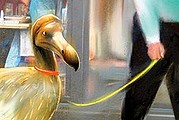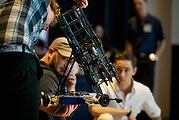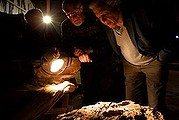
Ian Dunlop to take on BHP with climate change platform
Deborah Snow A former Australian coal company executive has become the would-be David to BHP Billiton's Goliath, taking on the mining giant with a bid to join its board on a platform of radical action against climate change.
Latest science news
'Space cannon' to be fired into asteroid: Japan

Japanese scientists preparing to blast a crater in an asteroid to find out what it is made of say they have successfully tested their new space cannon.
Most distant galaxy in the universe discovered

Meeri Kim Scientists have discovered the most distant galaxy ever confirmed, providing a snapshot of the early universe.
Norwegian town Rjukan installs giant mirrors to reflect light into valley

A town in Norway has placed giant mirrors on top of the hills surrounding it, to beam light into the valley in the dark winter months.
Scientists now the man with the golden gum

BRIDIE SMITH Money may not grow on trees but researchers have found that the next best thing does. Gold.
Global landmarks backed-up digitally in 3D

Raphael Satter A non-profit has created digital copies of more than 100 of the world's best-known monuments.
Einar Enevoldson, 81-year-old glider pilot, set for record-breaking flight to stratosphere

Matthew L. Wald A team of specialists and entrepreneurs is hoping to send a glider 27 kilometres high for a closer look at what ails the atmosphere.
Hair-raising discovery in pursuit of a cure for baldness

RACHEL WELLS Researchers have made a big breakthrough in the treatment of baldness but it is not for the faint-hearted.
How technology captures music's soothing power

CATHERINE ARMITAGE Most things lose their mystique if you look at them for long enough, and so it is proving with music, except you need to listen, not look.
Far out - these images will really tease the brain

BRIDIE SMITH To the untrained eye, the web of coloured wires rising and falling en masse across the wall of 3D screens looks like someone has let loose with a can of silly string, photographed the resulting mess and then zoomed in on a colourful cluster.
'Cave' men lead scientific way with revolutionary 3D imaging
![mcj 16th Oct. 2013
Professor C. Paul Bonnington [left] and Computational Imaging Scientist Dr. David Barnes peruse 3D images of the human brain at
Monash University's Cave2, the world's most advanced 2D/3D
Virtual reality lab.
The Age/News, Picture Michael Clayton-Jones, Clayton, Story Bridie Smith mcj 16th Oct. 2013
Professor C. Paul Bonnington Director Monash University e-Research Centre [left] and Computational Imaging Scientist Dr. David Barnes peruse 3D images of the human brain at
Monash University's Cave2, the world's most advanced 2D/3D
Virtual reality lab.
The Age/News, Picture Michael Clayton-Jones, Clayton, Story Bridie Smith](http://web.archive.org./web/20131026121521im_/http://images.theage.com.au/2013/10/18/4842662/th-bonnington-90x60.jpg)
Bridie Smith To the untrained eye, the web of coloured wires rising and falling en masse across the wall of 3D screens looks like someone has let lose with a can of silly string, photographed the resulting mess and then zoomed in on a colourful cluster.
Exoplanets, orphans of the universe

PETER SPINKS Once thought to be the stuff of science fiction, scientists are learning more about these mysterious rogues.
1.8 million-year-old skull gives glimpse of our evolution

Elizabeth Lopatto Skull suggests long-debated distinctions about early human development may be overblown.
Meteorite chunk lifted from Russian lake

Russian divers have pulled from a murky lake a half-tonne meteorite said to have been part of a meteor whose shockwave hurt 1200 people in Chelyabinsk earlier this year
Identified flying object

ASTRONOMY Is it a UFO? Perhaps it's a supernova? Could it be Comet ISON? Are we in any danger?
Telescope looks into deep past

BRIDIE SMITH The most powerful low-frequency radio telescope in the southern hemisphere is searching for radio waves almost as old as the universe itself.
Blood found in 46-million-year-old mosquito

NICKY PHILLIPS Researchers have found components of red blood cells in a 46-million-year-old fossilised mosquito.
Push for lift-off on drone deliveries in Australia

BEN GRUBB Australia may soon be the first country in the world to see commercial courier deliveries by drone, if a launch by a textbook rental service and an Australian tech start-up goes according to plan.
Don't turn your nose up at evolution of revulsion

CATHERINE ARMITAGE Hold on to your breakfast. Two recent news items were truly disgusting. Not in the politically correct sense of making you outraged about inequity or immorality, but in the evolutionary sense of making your stomach churn, your nose screw up and your mouth turn down.
Scientists find evidence of an apocalypse in another planetary system

John von Radowitz Evidence of an apocalypse in a planetary system similar to our own has been uncovered by astronomers studying a dying star.
Lonely planet in star turn all of its own, say astronomers

Ban on Chinese sparks scientists' boycott of NASA meeting

Prominent US astronomers are boycotting a NASA meeting next month on exoplanets because Chinese scientists have been banned from attending, experts say.
Molecular chemists win Nobel Prize for Chemistry

Three molecular chemists have won the Nobel Prize for Chemistry for devising computer simulations that are used to understand and predict chemical processes, the jury said.
First-ever comet material discovered on Earth

A comet exploded over Egypt 28 million years ago, raining down fire and leaving behind a "mysterious" black pebble - the first-ever comet material found on Earth.
Voyager: to boldly go ...

PETER SPINKS Spacecraft such as the Voyager probes are expanding our celestial understanding.
Hope for malaria answers

BRIDIE SMITH Every person infected with malaria carries about 12 billion malaria parasites. The parasites evolve constantly, staying one step ahead of the body's immune system and rendering malaria a life-threatening disease.
Higgs boson scientists win Nobel prize

Peter Higgs of Britain and Francois Englert of Belgium have won the Nobel prize in physics for the discovery of the "God particle", or Higgs boson, that explains why mass exists.
Why cheating feels good

Jan Hoffman If you don't think your cheating will hurt anyone, you may feel great about it, new research shows.
Dying for sex: it's a male marsupial thing

NICKY PHILLIPS In what may be the ultimate sacrifice for lust, Australian scientists have discovered why the males of some species of marsupial are dying for sex.
Cell researchers win Nobel prize

US duo James Rothman and Randy Schekman and German-born Thomas Suedhof won the Nobel Medicine Prize on Monday for their groundbreaking work on how the cell organises its transport system, the jury said.
The body builders

Andy Coughlan Our natural 'scaffolding' can help regenerate everything from bones to brains.
Features
The secret to running repairs
Scientists think the Mexican walking fish may hold the key to regeneration in humans.
Alive as a dodo
Bringing animals back from extinction is no longer science fiction. But the question is, should we do it?
Don't forget Alzheimer's
Society can't afford to ignore dementia.
The universe on a dinner plate
This astrophysicist has 95 per cent of, well everything, to sort out.
Videos
Student robots battle
They operate autonomously, can move through mazes, identify objects ...
New fossil site in outback Queensland
Scientists have discovered ancient mammals bones
Attenborough visits fish fossils
Sir David Attenborough visits remarkable NSW fossil site
Furry Facts
Why onions make you cry
Ever wonder why chopping onions is such a tear jerking event? Cartoonist John Shakespeare and science editor Nicky Phillips explain.
Vaccines
Needles aren't a whole lot of fun, but why is immunisation so important?
El Nino and La Nina
Have you ever found it hard to understand why Australia's swings between drought and floods?
Tornadoes
They're some of the most destructive forces on the planet, but what's the difference between a tornado and a cyclone?
Sinkholes
What is a sinkhole?























